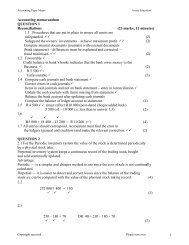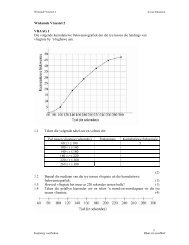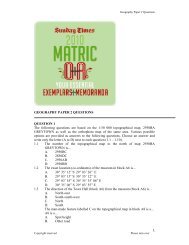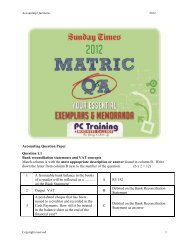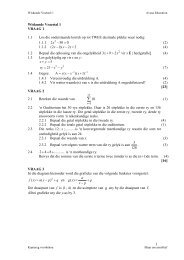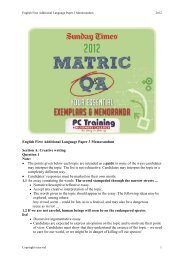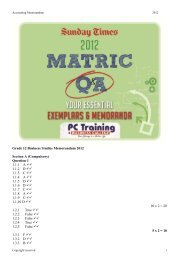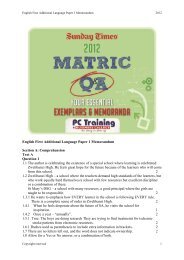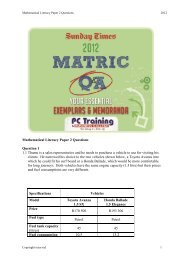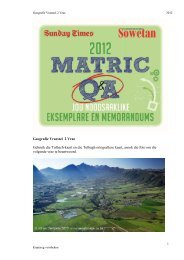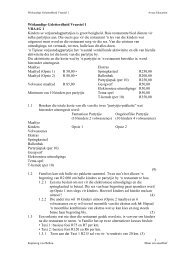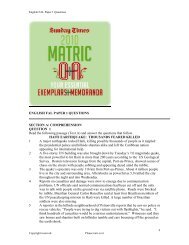GRADE 12 - Times LIVE
GRADE 12 - Times LIVE
GRADE 12 - Times LIVE
Create successful ePaper yourself
Turn your PDF publications into a flip-book with our unique Google optimized e-Paper software.
Accounting Question Paper<br />
Avusa Education<br />
Accounting Question Paper<br />
QUESTION 1<br />
Reconciliations<br />
(23 marks; 11 minutes)<br />
1.1 Bank reconciliation<br />
You are provided with three examples of reconciliations done by employees in the accounting<br />
department of Jordan Traders.<br />
Required:<br />
Study the information provided and then answer the questions that follow.<br />
Information:<br />
Example A<br />
Bank reconciliation statement on 28 February 2009<br />
Debit Credit<br />
Balance per Bank Statement 8 000<br />
Outstanding deposit 3 000<br />
Outstanding cheques:<br />
No 1040 dated 13 Feb 2009 2 200<br />
No 1052 dated 18 Aug. 2009 10 000<br />
No 1055 dated 28 Feb. 2009 4 300<br />
Balance per Ledger Account <br />
Example B<br />
Creditors’ reconciliation statement on 28 February 2009<br />
Ace Wholesalers<br />
R<br />
Balance per Creditors' Statement on 28 Feb 2009 Debit 5 000<br />
Invoice not reflected on statement: Invoice No 225 18 400<br />
Invoice on statement but not in Creditors Ledger: Invoice No 187 3 100<br />
Payment not reflected on statement: Dated 23 Feb 2009 9 000<br />
Returns not reflected on statement: Debit note No 44 1 100<br />
Balance per Creditors Ledger Account on 29 Feb 2009 <br />
Example C<br />
Reconciliation of creditors’ control account to the creditors’ list on 28 February 2009<br />
R<br />
Balance per Creditors' Control Account 46 000<br />
Balances per Creditors' Ledger 47 900<br />
Ace Wholesalers <br />
Busta Furnishers 20 000<br />
Copyright reserved Please turn over 1
Accounting Question Paper<br />
Avusa Education<br />
Camel Security Services <strong>12</strong> 000<br />
Dumbo CC <br />
Difference 1 900<br />
1.1 Briefly explain:<br />
• What you understand by the term internal control (2)<br />
• Why is it important to apply internal control in a business (2)<br />
• Why preparing reconciliations is important for internal control. (2)<br />
1.2 According to the Bank Statement, does this business have a favourable bank balance<br />
or a bank overdraft Give a reason for your choice. (2)<br />
1.3 Calculate the bank balance in the Ledger of Jordan Traders on<br />
28 February 2009. State whether this is a favourable or unfavourable balance. (3)<br />
1.4 List FOUR steps you would follow when preparing a Bank Reconciliation<br />
Statement. (4)<br />
1.5 When preparing the financial statements of Jordan Traders at the end of<br />
February 2009, what amount would you reflect under Cash and Cash<br />
Equivalents on the Balance Sheet (2)<br />
1.6 Calculate the correct amount owed to Ace Wholesalers by Jordan Traders. (4)<br />
1.7 Briefly explain what action should be taken over the difference of R1 900<br />
reflected in Example C. (2)<br />
QUESTION 2<br />
Inventory valuation and control<br />
(30 marks; 18 minutes)<br />
The following information relates to the trading activities of Micro Traders for the financial year<br />
ended 29 February 2009.<br />
The business is owned by BA Crooke. The business sells only one type of microwave oven and has<br />
decided to keep the selling price constant throughout the year.<br />
Mr Crooke is keen to secure a loan from the bank. He wants to ensure that the profit in the financial<br />
statements creates a very favourable impression with the bank.<br />
The business uses the periodic inventory system and the FIFO method of valuing stock.<br />
Information:<br />
Number Unit price Total<br />
of units R R<br />
Sales 1 400 252 000<br />
Stock on hand on 1 March 2008 40 units 950 38 000<br />
Purchases during the year 210 units 170 000<br />
June 2008 30 units 900 27 000<br />
October 2008 80 units 850 68 000<br />
January 2009 100 units 750 75 000<br />
Required:<br />
2.1 Explain the difference between the periodic and perpetual inventory systems.<br />
Also explain the advantage of each system. (4)<br />
2.2 Calculate the total number of microwave ovens sold during the year. (3)<br />
2.3 Calculate the total number of microwave ovens on hand at 28 February 2009. (3)<br />
The business uses the FIFO valuation method.<br />
2.4 Calculate the closing stock using the FIFO method. (3)<br />
Copyright reserved Please turn over 2
Accounting Question Paper<br />
Avusa Education<br />
2.5 Calculate the gross profit for the year ended 28 February 2009 using the FIFO stock<br />
valuation method. You may draft the Trading Account to calculate this figure. (5)<br />
In order to secure the loan the owner, BA Crooke, wants to change the stock valuation<br />
method to the weighted average method.<br />
2.6 Calculate the value of the closing stock by using the weighted average stock valuation<br />
method on 28 February 2009. (5)<br />
2.7 Calculate the gross profit for the year ended 28 February 2009 using the weighted<br />
average stock valuation method. You may draft the Trading Account to calculate this<br />
figure (3)<br />
2.8 In your opinion, will it be ethical for Mr Crooke to change the method of stock valuation<br />
Give ONE reason for your answer. (4)<br />
QUESTION 3<br />
Manufacturing<br />
(63 marks; 40 minutes)<br />
You are provided with information relating to Yum-Yum Enterprises for July 2008. The business<br />
makes tasty pellets for pets. The business is personally owned and managed by Peter Abrahams.<br />
Requited:<br />
3.1 Prepare the Production Cost Statement for July 2008. Show workings in brackets on the<br />
Production Cost Statement. (23)<br />
3.2 Prepare the Income Statement for July 2008. Show workings in brackets. (21)<br />
3.3 In order to be able to print the “Proudly South African” logo on the packaging of his product,<br />
Peter will need to purchase the card board boxes from a local supplier rather than import them<br />
from Botswana.<br />
3.3.1 Give TWO reasons why using a local supplier is likely to reduce the unit cost calculated<br />
above. (2)<br />
3.3.2 Calculate the unit cost of producing a complete box of tasty pellets in July 2008. (3)<br />
3.3.3 By doubling production to 70 000 units during August 2008 the profit will more<br />
than double. Briefly explain why. (2)<br />
3.4 In order to analyse the performance of the business, the accountant knows that it is essential to<br />
work out the break-even point of production.<br />
3.4.1 Calculate the break-even-point in units. (10)<br />
3.4.2 Should the accountant be happy with the business’ present production level Why (2)<br />
Information:<br />
1. Production and sales information of Yum-Yum Enterprises July 2008<br />
Number of finished boxes of pet pellets produced 35 000<br />
Number of units sold 30 000<br />
Mark-up cost 40%<br />
Selling price per unit <br />
2. Stock at the beginning and end of the month 1 July 2008 31 July<br />
2008<br />
Raw material stock:<br />
• Stock of ingredients to make pet pellets<br />
• Stock of card board boxes<br />
R70 000<br />
Nil<br />
R85 000<br />
R14 400<br />
Work-in-process stock R20 000 R24 000<br />
Finished goods stock R1 400 R7 000<br />
Copyright reserved Please turn over 3
Accounting Question Paper<br />
Avusa Education<br />
Indirect material stock (cleaning materials) Nil Nil<br />
Stock of packing materials for deliveries R4 200 R1 300<br />
3. Raw materials (brought from local supplier) comprise all ingredients for the production of pet<br />
pellets as well as cardboard box containers (imported from a supplier in Botswana):<br />
• Ingredients were bought during the month on credit for R330 000 (these were delivered free<br />
of charge).<br />
• Bought 60 000 cardboard boxes from Botswana for a total cost of 24 000 Botswana pula.<br />
One Botswana pula is equivalent to R1.30.<br />
• Import duty is 10%.<br />
• Transport cost paid on these boxes, R8 100.<br />
4. Remuneration is as follows:<br />
• The <strong>12</strong> direct workers are each required to work 180 hours per month, in other words, 20<br />
days at 9 hours per day. Their normal rate of pay is R30 per hour. However, during July 60<br />
hours were lost as a result of Eskom power cuts. The workers were required to work 60<br />
hours overtime weekends but only 10 workers were available for this. The overtime rate is<br />
double the normal rate.<br />
• The factory foreman is paid a fixed salary of R<strong>12</strong> 000 per month irrespective of overtime.<br />
He had to be paid a bonus of R8 000 for working over the weekends.<br />
• The bookkeeper is paid a monthly salary of R5 600.<br />
• The cleaner is paid a fixed salary of R4 000 per month. This is split between the factory,<br />
the office and the sales department in the ratio 5:2:3.<br />
• The sales people were paid commission of R42 380 in total.<br />
5. Electricity and water paid during the month was R27 800. This has been allocated as follows:<br />
• Office: R450<br />
• Sales department: R1 200<br />
• The factory plant and machinery accounts for the rest.<br />
6. Cleaning materials bought for cash, R14 200. Transport costs on these were paid out of the<br />
petty cash, R800. All these materials were used. The factory uses 80% of these indirect<br />
materials, while the rest is used equally by the administration, selling and distribution<br />
departments.<br />
7. Rent paid was R16 000. This is to split according to floor area:<br />
• Factory 400 square metres<br />
• Office 30 square metres<br />
• Sales department 70 square metres<br />
8. Depreciation for the month:<br />
• Depreciation on delivery vehicle, R5 800.<br />
• Depreciation on factory plant, R45 000.<br />
• Depreciation on office equipment, R800.<br />
9. Other transactions for July:<br />
• Packing materials (for deliveries to customers) bought, R7 200 (R1 300 of this was unused).<br />
• Petrol bought for the delivery vehicle and salesmen’s sales vehicles, R16 500.<br />
• Repairs to factory machines, R58 400.<br />
QUESTION 4<br />
Financial statements and audit<br />
(107 marks; 65 minutes)<br />
There are three parts to this question. Each part must be seen independent from the other.<br />
Part A<br />
4.1 The following information was extracted from the accounting records of Spencer Company Ltd.<br />
Copyright reserved Please turn over 4
Accounting Question Paper<br />
Avusa Education<br />
Required<br />
4.1.1 Complete the Income statement for the year ended 30 June 2009.<br />
Note: Certain information has already been filled in for you. (22)<br />
4.1.2 Prepare the following notes to the financial statements for the year ended<br />
30 June 2009:<br />
Accumulated profit (7)<br />
Trade and other payables (<strong>12</strong>)<br />
4.1.3 Prepare the Equity and liabilities section of the Balance sheet on 30 June 2009. (<strong>12</strong>)<br />
Information to prepare the Income statement<br />
1. Spencer Company Ltd operates on a profit mark-up of 80% on cost price.<br />
2. Gross profit achieved on 30 June amounted to R320 000.<br />
3. Rent income amounted to R3 500 per month from 1 July 2008. The rental agreement<br />
stipulated an increase of 10% as from 1 April 2009. The amount for rent income appeared<br />
as R50 500 in the Pre-adjustment trial balance on 30 June 2009.<br />
4. Insurance for the year amounted to R21 750. Included in this amount is an amount of<br />
R3 750 paid on an annual insurance contract on 1 March 2009.<br />
5. On 1 July 2008, the loan from Absa Bank had a balance of R450 000. In terms of the loan<br />
agreement interest is calculated at 18% per annum and is paid half-yearly. The capital sum of<br />
the loan is to be repaid in installments of R50 000 on 31 October of each year. The repayment<br />
to Absa Bank was made on 30 October 2008. The interest on loan account had a debit balance<br />
of R68 000.<br />
6. The bookkeeper has already calculated depreciation on assets as R32 000. It has now<br />
been discovered that this has been overstated by R3 000.<br />
7. Operating expenses as a percentage on sales for the year ended 30 June 2009, 20%.<br />
8. Income tax for the year ended 30 June 2009 amounted to R45 080. Income tax is<br />
calculated at 28%.<br />
9. Provisional income tax paid to SARS for the financial year ended amounted to R39 080.<br />
10. Total dividends declared and paid during the financial year amounted to R29 500. Of this<br />
R18 000 is still owed to shareholders for their final dividends declared but not yet paid on<br />
30 June 2009.<br />
11. The accumulated profit account had a balance of R72 000 on 1 July 2008.<br />
Information to prepare the Equity and Liabilities section of the Balance sheet and notes to the<br />
Balance sheet<br />
<strong>12</strong>. Trade and other receivables amounted to R322 000 on 30 June 2009 and the current ratio on<br />
this date was 2.3:1.<br />
13. Ordinary shareholders equity amounted to R1 200 000 on 30 June 2009.<br />
14. Spencer Company Ltd has 36 000 shares in issue with a par value of R25 each.<br />
Part B<br />
4.2 The following information was extracted from the accounting records of Labels Are Me Ltd.<br />
Required:<br />
4.2.1 Prepare the note to the Cash flow statement for the year ended 30 June 2009:<br />
Reconciliation of profit before tax and cash generated from operations (21)<br />
Fixed assets purchased (6)<br />
4.2.2 Prepare the cash flow from operations section of the Cash flow statement for the year<br />
ended 30 June 2009. Show calculation in brackets to earn part marks. (14)<br />
Copyright reserved Please turn over 5
Accounting Question Paper<br />
Avusa Education<br />
Information:<br />
1. The following information was extracted from the accounting records of Labels Are Me Ltd for<br />
the year ended 30 June 2009 with comparative figures for 2008.<br />
30 June 2009 30 June 2008<br />
Mortgage bond 750 000 900 000<br />
Loan from Absa 250 000 250 000<br />
Land and buildings 2 400 000 1 700 000<br />
Vehicles 480 000 380 000<br />
Equipment 310 000 275 000<br />
Accumulated depreciation on vehicles 240 000 140 000<br />
Accumulated depreciation on equipment 110 000 88 000<br />
Trading stock 572 000 610 000<br />
Trade debtors 325 000 280 000<br />
Accrued income 8 000 5 000<br />
SARS (Income tax) 22 200(DR) 15 800(CR)<br />
Bank 79 300 16 000(CR)<br />
Trade creditors 477 300 430 000<br />
Accrued expense (Interest on Loan) 3 500 5 200<br />
Income received in advance 7 700 10 000<br />
Shareholders for dividends 140 000 <strong>12</strong>5 000<br />
2. Additional information<br />
2.1 The net profit before tax amounted to R1 280 000 and income tax is calculated at 30% of<br />
pre-tax profits.<br />
2.2 A vehicle costing R80 000 was sold at carrying value, R35 000. No equipment was sold<br />
during the financial year.<br />
2.3 The following interest was incurred during the financial year:<br />
• Interest on mortgage bond, R98 250<br />
• Interest on loan, R26 750<br />
• Interest on overdraft, R2 000<br />
2.4 An interim dividend of R286 000 was declared and paid on 1 December 2008.<br />
Part C<br />
4.3 Read the following carefully then answer the questions below.<br />
Sven Johannson is an investor in Labels Are Me Ltd. He owns 21 000 shares in the business.<br />
14 500 were purchased on 1 July 2007 for R5.50 each and the remainder were purchased on<br />
1 July 2008 when the company made a further allocation of shares at R6.15 each.<br />
30 June 2009 30 June 2008<br />
Earnings per share (EPS) 134 cents <strong>12</strong>0 cents<br />
Dividends per share (DPS) 115 cents 95 cents<br />
Return on shareholders equity 22.07% 20.2%<br />
Net assets value per share (NAV) R6.29 R6.25<br />
Average trading price on the JSE for the year ending R7.00 R7.11<br />
Interest on Fixed Deposit 6.5% 6%<br />
Questions:<br />
Sven bought the share in Labels Are Me Ltd because a friend told him that this was a good investment.<br />
Copyright reserved Please turn over 6
Accounting Question Paper<br />
Avusa Education<br />
Sven has asked for your help with the following:<br />
4.3.1 Calculate how much Sven received in dividends from Labels For Me Ltd for the year<br />
ending 30 June 2009. (3)<br />
4.3.2 As a shareholder in Labels For Me Ltd should he be happy with the dividends declared and paid<br />
by the company for the year ended 30 June 2009 Quote the relevant figures from the above table<br />
to substantiate your answer. (5)<br />
4.3.3 Sven is not quite sure if he should keep his investment in Labels For Me Ltd or sell his<br />
shares on the JSE. Advise Sven on what he should do by quoting figures from the above<br />
table to help him make an informed decision on keeping or selling the shares. (5)<br />
QUESTION 5<br />
Interpretation of financial information<br />
(40marks; 24 minutes)<br />
Use the detachable Data Sheet (appendix A; page) as well as the information below to answer the<br />
questions that follow.<br />
Information:<br />
John Smith, a food and beverage manager at Hilton Hotel, has inherited R1 000 000. He wishes to<br />
invest the money to gain maximum capital growth for a medium-term investment.<br />
Two options are available to Mr Smith — he can either buy shares in CAWOOD Ltd or he can buy<br />
into an existing close corporation trading as SINGH CC.<br />
CAWOOD Ltd is a construction company. The directors are investigating a possible BEE deal.<br />
This deal will ensure additional share capital as well as being able to position themselves favourably<br />
for government contracts in the future.<br />
SINGH CC is an upmarket delicatessen that specialises in the selling of elite imported food items as<br />
well as a selection of expensive luxury “proudly South African” products. SINGH CC is a secondgeneration<br />
organisation located in La Lucia Mall. The owners pride themselves on the personal<br />
services they offer to their regular elite customers.<br />
Questions:<br />
5.1 Name two parties who would be interested in the audited financial statements of CAWOOD<br />
Ltd. (2)<br />
5.2 What is the difference between Authorised and Issued Share Capital<br />
Why is it necessary for both these figures to be reflected in the published financial<br />
statements (3)<br />
5.3 It is possible that for SINGH CC to make its business look attractive to potential investors they<br />
may have overstated (inflated) their turnover figure.<br />
How is this problem prevented in CAWOOD Ltd (2)<br />
5.4 Identify three ratios that Mr Smith should utilise in analysing the audited financial<br />
statements of CAWOOD Ltd before deciding whether he should invest in the<br />
company or not. (3)<br />
5.5 To secure the possible BEE deal, CAWOOD Ltd needs to raise a further R5 000 000.<br />
How could the company raise the necessary finance Discuss the positive effects that the<br />
securing of the BEE deal will have on the overall performance of the company. (8)<br />
5.6 Due to the continued unexpected slump in the South African economy,<br />
SINGH CC is currently experiencing liquidity problems. A possible solution would be<br />
to attract an additional member to the CC. Identify two advantages, relevant to SINGH CC,<br />
of signing on an additional member. (2)<br />
5.7.1 Mr Smith has done extensive research into SINGH CC and has raised a few concerns,<br />
one of which is the liquidity problem that the CC is currently experiencing.<br />
Write a paragraph, on behalf of SINGH CC, to Mr Smith that highlights the positive<br />
Copyright reserved Please turn over 7
Accounting Question Paper<br />
Avusa Education<br />
financial aspects of the business. Ensure you cover the following aspects in<br />
your motivation: goodwill; profitability; and return on investment. (9)<br />
5.8 The “buy in” price for SINGH CC is R700 000 and it is projected that a loan<br />
of R300 000 will be needed in the second half of the financial year. Discuss<br />
TWO reasons why it would be beneficial for Mr Smith to offer a loan to the<br />
CC rather than to have the CC borrow the funds from a commercial bank. (4)<br />
5.9 Based on the information that has been provided, you are required to advise<br />
Mr Smith as to which investment would fulfil his investment criteria. Quote<br />
figures, where necessary, to substantiate your answer. (7)<br />
Appendix A<br />
DATA SHEET<br />
BEE: Black Economic Empowerment<br />
The development and economic empowerment of historically<br />
disadvantaged people, including all non-white people, for example,<br />
Africans, Indians, coloureds and Chinese.<br />
CAWOOD Ltd<br />
SINGH CC<br />
2008 2007 2008 2007<br />
Authorised Share Capital (R2.00) 10 000 000 10 000 000<br />
Issued Share Capital (R2.00) 4 500 000 3 500 000<br />
Capital Employed 1 200 000 1 000 000<br />
Return on Shareholders Equity 34% 43%<br />
Dividends per Share 56 c 40 c<br />
Earnings per share 90 c <strong>12</strong>0 c<br />
Return on Capital Employed 38% 40 %<br />
Long term loans (16%) 3 000 000 2 000 000 50 000 10 000<br />
Debt:Equity ratio 0.46 : 1 0.35:1 0.04:1 0.01:1<br />
Acid test ratio 1.75 :1 1.9 :1 0.3 : 1 0.8 :1<br />
Current Ratio 2.1:1 1.9 : 1 0.9 : 1 1.1 : 1<br />
Net profit/Turnover 45 % 56 % 32 % 41 %<br />
Operating Expenses on Turnover 51 % 31 % 43 % 39 %<br />
Achieved mark up % 1<strong>12</strong> % <strong>12</strong>0% 90 % 100%<br />
Actual Mark up % <strong>12</strong>5% <strong>12</strong>5 % 100% 100%<br />
Goodwill – the name of the game! - Clifton <strong>Times</strong> 21 August 2008<br />
Peter Mallet, owner of Peter Pans, a catering company situated in Durban North<br />
showed us once again what it means to care for your customers. Mr Mallet has<br />
secured an elite niche market amongst the who’s who of Durban North. He caters for<br />
private cocktail functions at residential homes.<br />
On 9 August he came to the rescue of Mrs Robinson. Mrs Robinson had invited 20<br />
distinguished guests to a cocktail party at her residence. Much to her dismay, at<br />
17h00, 2 hours before the guests were due to arrive, her long-time domestic worker<br />
and assistant walked out of the house stating that because it was Women’s Day they<br />
deserved the night off.<br />
Mrs Robinson was horrified. She immediately phoned Mr Mallet for his assistance.<br />
Copyright reserved Please turn over 8
Accounting Question Paper<br />
Avusa Education<br />
Mr Mallet agreed to leave his son’s school function to come and assist her in her<br />
plight. The evening was a huge success.<br />
Needless to say, the guests left with Mr Mallet’s business card carefully tucked into<br />
their top pockets!<br />
This poses the question: Does the business make the business or is it the man who<br />
makes the business<br />
QUESTION 6<br />
Debtors’ collection and cash budget<br />
(37 marks; 22 minutes)<br />
You have recently been appointed bookkeeper of Mutzim Dealers (Pty) Ltd. This business sells<br />
household electrical appliances, from kettles to washing machines. You are required to use the<br />
information given to complete the questions that follow.<br />
Information:<br />
Mutzim Dealers (Pty) Ltd<br />
Cash budget for the period 1 October — 31 December 2008<br />
Cash receipts October November December<br />
Cash sales 45 000 66 000 *<br />
Cash Received from debtors 27 000 * *<br />
Sale of old computers - 6 000 -<br />
Rent income 4 000 2 000 2 000<br />
Total receipts 76 900 * *<br />
Cash payments<br />
Payments to creditors 32 000 30 000 *<br />
Salaries 15 000 15 000 15 000<br />
Advertising 1 050 1 250 1 300<br />
Interest on loan 1 500 1 500 1 050<br />
Other operating expenses 15 000 15 500 16 010<br />
New computers bought - - 24 000<br />
Loan repayment - - 30 000<br />
Total payments 64 550 63 250 *<br />
Cash surplus/shortfall <strong>12</strong> 350 * *<br />
Bank – opening balance 8 000 20 350 *<br />
Bank – closing balance 20 350 * *<br />
Additional information:<br />
1. Sales figures.<br />
Actual (40% on credit)<br />
Budgeted (projected)<br />
August 2008 September October 2008 November 2007 December 2008<br />
2008<br />
R90 000 R80 000 R75 000 R110 000 R150 000<br />
2. During October and November of the budget period 40% of sales are expected to be on credit<br />
and the rest will be for cash. From 1 December 2008, credit sales are expected to increase by<br />
15%.<br />
3. Debtors are allowed 60 days credit and the amounts owing by debtors are expected to be<br />
collected as follows:<br />
Copyright reserved Please turn over 9
Accounting Question Paper<br />
Avusa Education<br />
• 50% in the month of sale, to take advantage of the 10% settlement discount allowed for<br />
prompt settlement.<br />
• 45% in the month following the sale.<br />
• The rest is written off as irrecoverable after three months.<br />
4. Trading stock on hand is maintained through monthly purchases.<br />
5. Cost of sales is equivalent to 40% of turnover.<br />
6. All stock purchases are on credit. Creditors are paid in the month following the purchases (after<br />
30 days).<br />
Required:<br />
6.1 Is the drawing up of a cash budget an aspect of Financial Accounting or<br />
Management Accounting (1)<br />
6.2 Why is a Debtors Collection Schedule drawn up when preparing a cash budget (1)<br />
6.3 Complete the cash budget by filling in the amounts marked with an asterisk (*). (19)<br />
6.4 The rental income is fixed at R2 000. Explain why the amount of R4 000 is<br />
reflected in October. Supply one possible reason. (1)<br />
6.5 Explain, quoting figures and/or policies, whether you think that they are<br />
effectively managing their working capital. (2)<br />
6.6 Mutzim Dealers (Pty) Ltd like other retailers in South Africa today are facing many<br />
challenges which are impacting on their future profits and cash flows. The<br />
following are some of these challenges. Read through them and comment on<br />
what effect you think each of them could have on the cash flow of Mutzim Dealers<br />
(Pty) Ltd.<br />
6.6.1 In June 2007 the South African government introduced the National Credit Act.<br />
According to this act, retailers are not allowed to give their customers credit<br />
facilities unless they have first checked on their income to ensure that they can<br />
afford to buy on credit, and if they can, how much credit they should be allowed. (2)<br />
6.6.2 South Africa cannot supply enough power to cope with demand and electricity<br />
tariffs are expected to increase by at least 30% and the worldwide shortage<br />
of fuel is pushing up the fuel price at an alarming rate. (2)<br />
6.6.3 The inflation rate is in double figures and, because of this increase in the cost<br />
of living, employees are demanding at least a <strong>12</strong>% increase in salaries. (2)<br />
6.7 As a result of the challenges mentioned in 2.6 above, the directors of<br />
Mutzim Dealers (Pty) Ltd are concerned about its future prospects and are<br />
wondering if they should close down the business. Advise them as to what you<br />
think they should do, giving reasons for your suggestions. (2)<br />
6.8 An employee of the company has informed the directors that some staff in the<br />
“goods returned department” are stealing faulty electrical products that have<br />
been returned by customers instead of returning these products to the suppliers<br />
in order for Mutzim Dealers (Pty) Ltd to get a credit on their account.<br />
The directors cannot understand how this can happen as they employ an internal<br />
auditor who should have detected this in his audit.<br />
6.8.1 What are your views on “whistle-blowing” (reporting on irregular or unethical<br />
actions by other members of staff) Your answer must include both the positive<br />
and negative aspects of “whistle-blowers” and should “whistle-blowers” be rewarded<br />
in some way by the company. (3)<br />
6.8.2 What two internal control measures can be put in place to prevent staff from<br />
taking faulty products returned by customers (2)<br />
Total: 300<br />
Copyright reserved Please turn over 10



